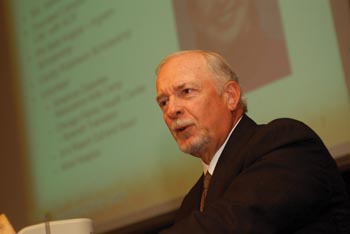
Harry Jacobson, M.D., vice chancellor for Health Affairs, outlined VUMC’s quality goals and initiatives at this week’s Fall Faculty Meeting.
photo by Dana Johnson
Faculty meet focuses on quality measures
Customer satisfaction is driven by employee satisfaction, which is driven by trust, Vice Chancellor for Health Affairs Harry Jacobson, M.D., told faculty and staff from the schools of Medicine and Nursing during Monday's fall meeting.
A focus on quality is growing in medical circles and Vanderbilt needs to be on the front end, he said, by ensuring that employees and patients have a personal experience equal to the quality of health care.
“If you think about it, organized medicine is sort of the last industry, if you will, to begin to look at quality,” Jacobson said.
“It is going to move so fast that we have got to get on board and get on board quickly with a commitment … if we all think it is something that someone else will do for us, it is never going to work.”
Most departments at the Medical Center are looking ahead to reach their elevate benchmarks — a 90 percent rating of excellence for overall service and medical care and 95 percent likelihood of returning and recommending Vanderbilt.
The Department of Emergency Medicine currently has a 97.4 percent rating for quality of care with 90.6 percent of patients saying they would return.
Corey Slovis, M.D., professor of Emergency Medicine and chair of the department, received applause when the numbers were shown during Monday's meeting.
Although the physical location of the ED has changed and now includes larger and more private rooms, Slovis said the most important change is his staff's approach to emergency care.
“Our care hasn't changed at all, but what has changed is letting the patient know how much we care about them as an individual. It is being more attentive to what the patient views as his or her emergency,” Slovis said.
“We've always focused on saving lives … now we let the patient know that we are going to take good care of them, that they are at Vanderbilt and they are safe. We try to go back within an hour or so and give them more information.”
“We are paying attention to them as a customer, as an individual, and not just as a patient,” he added.
Three clinical care areas stressed as a focus for improvement in the coming year are quality, customer service and being recognized as a workplace of choice.
Jacobson characterizes Vanderbilt as “good, but not yet great,” in those areas. “The more objective and measurable your goals are, the better,” he said.
Jacobson wants to be not only the dominant health care provider in Middle Tennessee, but also the top referral center in the Southeast and nationally recognized as among the top 10 medical centers.
Vanderbilt is also striving to be one of Fortune magazine’s 100 Best Employers by 2007.
Aside from goals, Vanderbilt is already rated as very good or excellent in several areas.
It now is the nation's fastest growing academic medical center in NIH funding with $322.6 million secured for research in 2005, two years ahead of projections.
Eight departments are in the Top 10 in NIH funding, with Physiology ranking first. Three departments — Radiology, Pediatrics and Anesthesiology — broke into the Top 10 this year and clinical departments including Surgery are improving at a rapid pace and could be in the Top 10 soon.
Jacobson said the School of Medicine does very well at placing its students, with 70 of 91 going on to residencies at Top 20 schools.
Vanderbilt's DNA database is about ready to launch and is expected to be the largest DNA repository worldwide within the next five years.
Financially, the institution will focus on “scaling up,” meaning the bottom line needs to grow as the top line grows. Growth measures set by Jacobson are for an increase of 10 percent in net revenue at Vanderbilt University Hospital and The Vanderbilt Clinic and 8 percent at the Vanderbilt Medical Group. He wants to increase the bottom line by 18 percent and then focus on building the reserves.
“We need to build the reserves so we have flexibility in case of hard times or a major opportunity that requires additional resources,” he said.
The Shape the Future Campaign is closing in on its goal of $1.25 billion in fundraising, with $1.13 billion already secured. The Medical Center has raised $501 million toward its $625 million goal.













